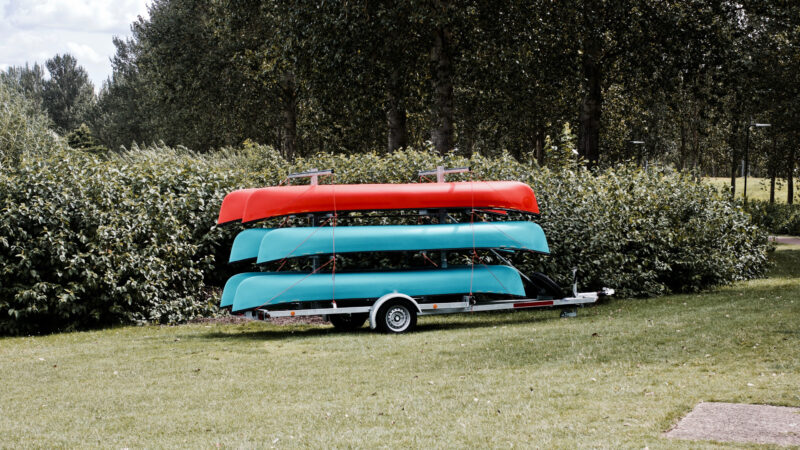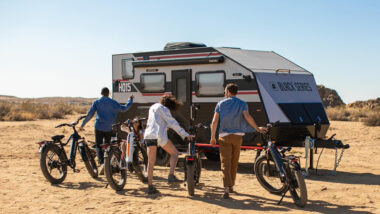Table of Contents Show
You’ve got the kayak. You know the water. Now the only problem is getting one to the other. You can’t wait to take your shiny new boat out for a spin.
But how can you get that kayak to the lake? You don’t have a rack for your vehicle. You also don’t relish the thought of muscling that heavy rig into the back of a borrowed truck by yourself every time you want to paddle.
Maybe it’s time to look into that kayak trailer as a part of your permanent kayak equipment.
What Is a Kayak Trailer?
A utility trailer made specifically to transport kayaks usually has two wheels and a tongue so that you can hook it up to a tow vehicle.
These vehicles have racks attached, where you can secure one or two kayaks for a trip, and each trailer is built for certain weights and lengths of boats.
When selecting a kayak trailer, be sure its capacity is sufficient for the rigs you intend to carry.
Keep in mind that many can handle up to 600 additional pounds of weight.
Depending upon the building material, a kayak trailer may weigh only 200 pounds when dry.
These utility trailers can be built with different structures, depending upon the types of toys you will be towing.
You can find single and tandem kayak trailers built only for hauling kayaks.
If you’d like to mix it up and use the trailer for river rafts or jetskis, an open aluminum flat trailer can do double or triple duty.
And one company has created a trailer that can tow your kayaks on top of its low clearance deck while bringing along a motorcycle beneath it!
What to Look for When Buying a Kayak Trailer
Since a kayak trailer should be an essential part of your boating equipment, know your specific needs before starting the shopping process.
Here are the many topics you should consider when narrowing down your trailer selection.
Material of Trailer
The material your kayak trailer comprises of will impact the trailer’s longevity, strength, and maintenance.
Many utility trailers consist of steel or lightweight aluminum.
Check to see if they got treatment for rust.
Also, consider the trailer’s wheels.
Trolley carts may have rubber wheels or plastic airless tires.
Be sure your selection can handle boat weight and the topography.
How Many Kayaks You’ll Be Transporting
If you’re only towing one kayak at a time, your options for a kayak trailer are numerous.
You may intend to carry more than one boat or if you would like to haul a variety of water toys.
Then, look for trailers that can handle more weight.
They should also have the room and attachment options to bring along all the goodies.
Also, consider the length of your kayak when purchasing, as some may not allow for longer boats.
Ease of Loading and Unloading
One of the best benefits of using a kayak trailer is avoiding the struggle of loading boats on the roof of your vehicle.
It takes a bit of stamina and sometimes even requires a second person to help.
But when shopping for a trailer, look for ones with boat placement lower to the ground.
On double-deckers, ensure you can get your kayak on the top deck without help and check on all securing attachments.
Keep in Mind: Have you considered building your own utility trailer camper? If so, you need to see these reasons why you should avoid building your own utility trailer camper.
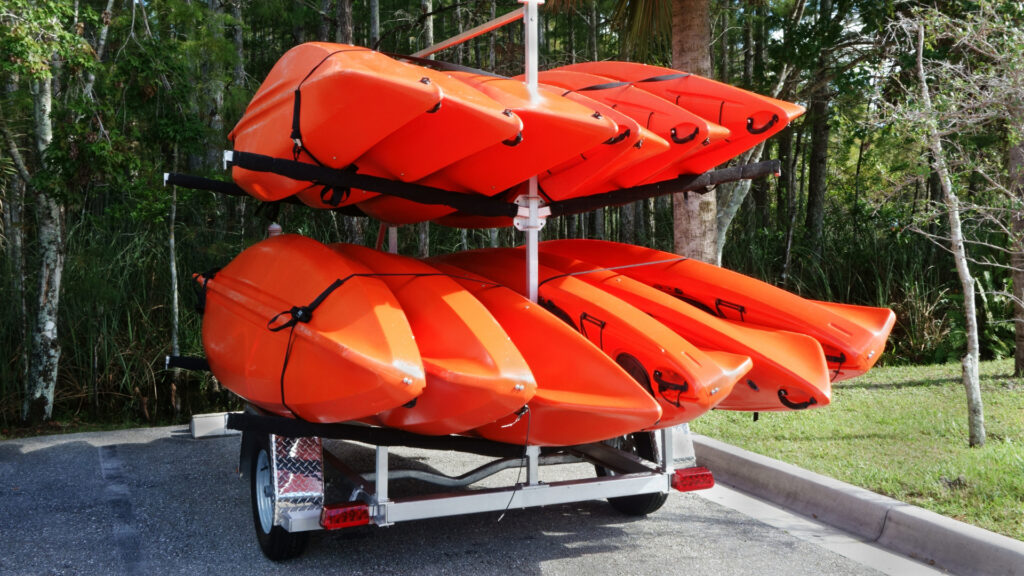
Distance You’ll Need to Transport Your Kayak
If you only need help to get your kayak from the house to the shoreline, you won’t need to invest in a towable kayak trailer.
Rather, a trolley or cart may be all that’s required to make your launch easy.
But hauling your boat(s) on a whitewater vacation may require a utility trailer to securely attach them, transporting them for miles.
Look for trailers that have high road clearance.
They should also have an extendable tongue, and plenty of room to bring along all of your toys.
The Best Kayak Trailers
There are several options for towing a kayak, from trolleys to double-decker trailers.
Using the criteria listed above, see if any of these kayak trailers will meet your needs.
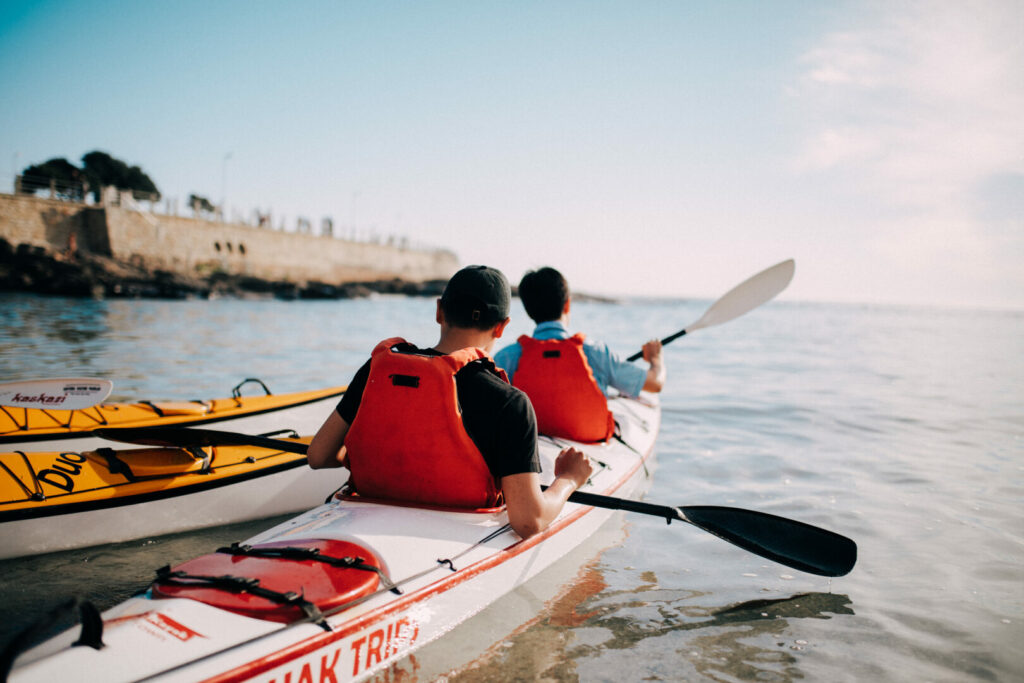
Best Overall: Malone Auto Racks MicroSport Kayak Transport Package
- Marine grade pre-galvanized steel frame, 78" wide x 159" long
- 78" coated steel cross rails (fits most attachments), 2" hitch
Made from galvanized steel, this four-packer is easy to load (no more putting them on the roof of your sports utility vehicle).
It has cross rails with four J-Pro 2 kayak carriers that can be detached so you can use the trailer for other towing.
Weighing in at 250 pounds, the Malone MicroSport is 78 inches wide and 164 inches long, able to handle most longer boats.
Pros: Towing four kayaks without trying to load them on a vehicle roof puts this trailer in the number one spot for us.
Also a plus, detachable carriers make the kayak trailer more useful for other types of towing.
Cons: The only detriment we can see is that this trailer can transport only 350 pounds.
That means the four kayaks you load can’t all be large ones.
Budget Option: RAILBLAZA Ctug Kayak Trolley Cart
- Puncture-free wheels with high grip rubber tread; Never worry about getting a flat tire on your kayak and canoe cart;...
- Durable Construction: The C-Tug is made of Reinforced composite material, thermos-bonded elastomeric hull pads, and...
Weighing in at just under 10 pounds, the Ctug Trolley Cart makes moving your boat from a tow vehicle to water easy enough for one person to handle even the biggest rig.
It can support canoes or kayaks that weigh up to 350 pounds, and its puncture-free rubber wheels can cross rough terrain without problems.
Pros: If you don’t have far to go, the Trolley Cart can be a back-saver.
Take your kayak through the sand to the water’s edge, or wheel it from your tow vehicle to a boat ramp.
We love how this equipment breaks down and is stored in the boat while paddling – no need to take it back to the car or leave it on the beach.
Cons: The Trolley Cart is a short-term solution for moving your kayak.
It’s insufficient for towing but can help you get your boat a short distance without too much strain.
Best for One Kayak: Malone EcoLight 1-Boat Kayak Trailer
- One medium to large sized recreational
- Fishing kayak with traditional
This one-boat trailer is extremely adaptable, with bunks for traditional and non-traditional hull boats and flat supports.
Backing the Ecolight down a boat ramp to unload is no problem, with 26-inch clearance.
The trailer measures 58 inches wide by 129 inches long and weighs 145 pounds.
It can handle kayaks up to 14 feet long and weighs up to 400 pounds.
Pros: The Ecolight is great for hauling fishing kayaks or small rigs with pontoons.
It’s also adaptable to tow other small water vehicles.
Cons: The only downside is that this kayak trailer comes unassembled, so you will need to spend three to five hours putting it together before use.
Keep in Mind: Looking for an area to camp and kayak at this summer? Then you’ll want to check out this Blue Ridge Reservoir Camping and Kayaking Guide
Best for the Beach: Kayak Cart Dolly Wheels Trolley
- DIMENSIONS: 27"L x 14"W x 18.5"H inches - Securing Strap 144”L x 1”W inches.
- CAPACITY: Our kayak dolly can carry up to 165 lbs. and includes a cam buckle tie down strap to secure your kayak, canoe,...
A trolley with no bells or whistles may be just what you need if you want to move your kayak from a tow vehicle to the water and back.
It’s 27 inches long and 14 inches wide with a 12-foot strap to hold your boat on the cart.
Airless tires give the dolly stability, making it a cinch for one person to maneuver a kayak to the shoreline.
Pros: It’s simple and reasonably trouble-free, meeting the need to move your kayak from one place to another close by.
Cons: The trolley folds up, but the closed size is not significantly small enough to store away in the boat.
This means every time you use it, you will have to store the cart in a car or leave it on the beach.
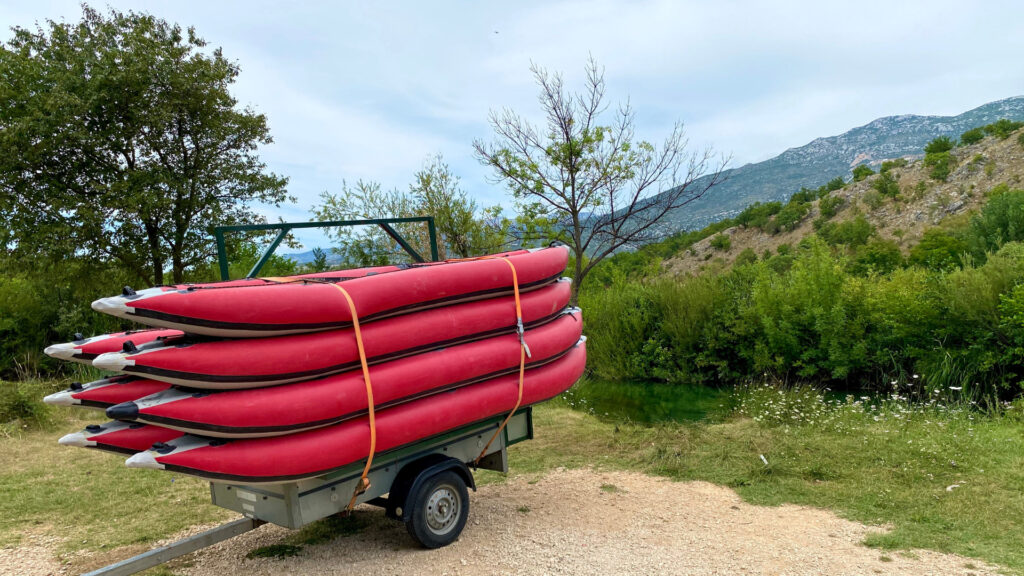
Best for Bringing Kayaks and Bikes: Multi-Rack Kayak Trailer
Here’s a double-decker trailer that can simplify your toy hauling. With multi-racks, bring along two kayaks or four, or add a couple of bikes or paddleboards.
There’s room for it all and the ability to add specific attachments for each piece of equipment.
This trailer weighs 205 pounds and can handle 300 pounds more.
So, mixing and matching your sporting equipment is a no-brainer.
Pros: Being able to bring everything along on a 12-foot trailer saves time, money, and physical effort.
The additional option to place specific equipment attachments on the cross members makes this multi-rack kayak trailer a frontrunner for outdoor enthusiasts.
Cons: The 8-inch tires may be a little undersized for the trailer.
Its accompanying weight, and the coated metal may lend itself to rust.
Make Transporting Your Kayaks a Breeze With a Trailer
Owning a kayak provides the freedom to explore quiet water or adventure through whitewater, fish on a calm lake, or paddle through sea surf.
But one piece of equipment that should be considered essential to your water play is a kayak trailer.
It will make each excursion seamless from home to a lake and back again, transporting your boat wherever the feeling moves you.
Do you own a kayak trailer? What’s your experience like?
Last update on 2024-12-23 / Affiliate links / Images from Amazon Product Advertising API




